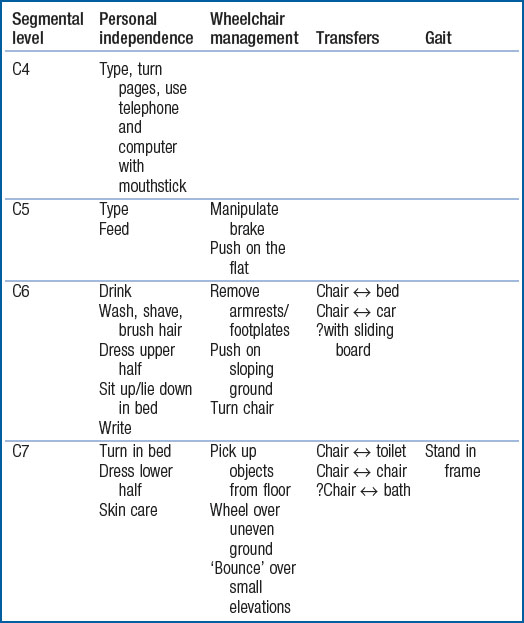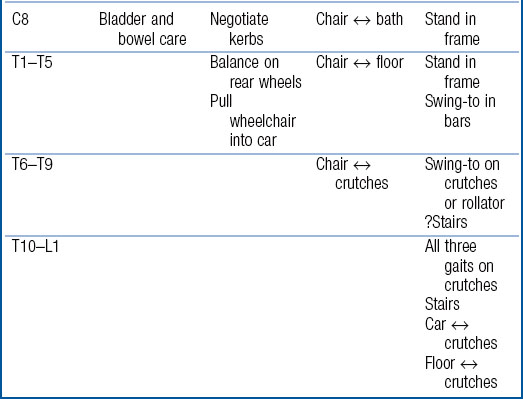Chapter 16 E-materials
Appendix 16.1 Spinal cord injury centres in the united kingdom and eire
Appendix 16.2 Spinal innervation of the muscles of respiration
| Muscle(s) | Innervation |
|---|---|
| Platysma | 7th cranial nerve (facial) |
| Sternocleidomastoid | 11th cranial nerve (accessory) |
| Trapezii | 11th cranial nerve (accessory) |
| Diaphragm | C3–5 |
| Scalenes | C3–8 |
| Pectorals | C5–T1 |
| Intercostals | T1–11 |
| Abdominals | T6–12 |
Appendix 16.4 Resources in the public domain
Case Study 16.1 Cervical C4 complete spinal cord injury (AIS A)
Initial assessment
• On admission to the SIU the following observations were recorded:
Acute/bedrest management and early rehabilitation
• On Day 1, IPPB was refused, so incentive spirometry was commenced instead, with reluctant compliance.
• Full passive upper limb ranging was performed, as was the case with lower limbs, limiting hip flexion to 30 degrees and using ‘frogging (half tailor position)’ to achieve full knee flexion range.
• The therapist liaised with the medical team regarding analgesia for neck pain and a positioning programme commenced for the upper limbs, using the ‘half crucifix’ position with the assistance of arm boards on one side and distal elevation of the contralateral upper limb by the patient’s side using a ‘ski-jump’ pillow.
• Occupational therapists assessed the patient for resting hand splints.
• NIV BiPAP via a facemask was commenced at the first sign of respiratory distress and elevated PaCO2.
• As cognitive function started to improve, habitual posturing of the shoulders in elevation was noticed, resulting in pain on passive shoulder flexion at 160° and palpation of bilateral upper trapezius muscles 8/10.
• The patient required intubation, due to minimal spontaneous respiratory effort. Chest physiotherapy included side to side turning using the turning bed mechanics, manual hyperinflation (MHI) with periodic inspiratory holds, adding bagged in nebulised mucolytics (e.g. Parvolex™) as secretions became thicker, expiratory shakes and closed circuit suction performed in time with manual assisted coughs.
• Regular assessment for respiratory activation was performed throughout whilst the patient was on the manual hyperinflation bag or IPPB.
• Upon return of function, vital capacity was recorded via the tracheostomy (Wright™ respirometer Mark 8) at 50 mL.
• As the routine became established, IPPB delivered via the tracheostomy replaced MHI to free up the therapist’s hands and to allow for spontaneous breath attempts.
• Positioning of the limbs and passive ranging continued as it had on the ward.
• When episodes of asystole began to present, each therapy session was preceded by prophylactic IV glycopyrrolate and 100% oxygen delivered through the ventilator 2 minutes prior to commencing treatment.
• A nurse was on standby with atropine should the heart rate drop and remain below 40 beats per minute.
• This ceased once the pericardial effusion was drained and no further bradycardic episodes were observed.
• Full range lower limb stretching was performed post lumbar surgery, including hip flexor stretches whilst the patient was turned to the side for washing.
• Neck stretches and active assisted neck range of motion exercises commenced post removal of the collar after the consultant’s permission was obtained.
• The Cough Assist™ machine was introduced upon returning to the ward and delivered by the nursing staff via the tracheostomy, twice daily post bronchodilator nebuliser to encourage regular secretion clearance.
• The father was taught this, along with tracheal suctioning by the senior physiotherapist, to maintain secretion clearance and also to assist the father’s parental desire to help his son in a practical fashion.
• Distal limb joint ranging was also taught to the father for this reason.
• Soft tissue massage of upper trapezius muscles, caudal and lateral scapulae glides and regular repositioning of the shoulders into depression was used to assist with shoulder pain.
• Heat and acupuncture were considered, but avoided due to inability of the patient to monitor response to the intervention.
• Following the report of loss of dorsiflexion range, bilateral UFOs (Universal Foot Orthoses) were utilised, slowly increasing the time period of application to monitor effects on the skin.
• Customised soft/scotch casts were avoided due to the varying limb circumference evident post spinal injury.
• As spontaneous respiratory efforts recommenced, IPPB was utilised with a gradual increase of the trigger (lower sensitivity) as improvements occurred.
• This functioned as ‘biofeedback’ for a neurological system undergoing plasticity.
• Progression came with the use of a low vital capacity incentive spirometer (e.g. Cliniflo™) via the tracheostomy with entrained supplemental oxygen.
• Upon permission to mobilise out of bed, preparations were made by sourcing a suitable tilt-in-space wheelchair and cushion and sitting up in bed with an abdominal binder in situ using the inbuilt bed mechanics.
• The father was taught the bed controls and together they progressed subjective tolerance of the upright position in bed.
Re-assessment post-mobilisation
• A repeat formalised neurological check identified a new diagnosis of C2 AIS A tetraplegia with a zone of partial preservation between C3–4.
• Repeat muscle chart showed bilateral grade 4 shoulder elevation and grade 2 scapulae retraction. All other muscles were absent. Sensation was normal to the C2 key point, impaired to C4 and absent below.
• Shoulders achieved full range flexion, but with pain above 160 degrees. Ankle dorsiflexion was limited to 10° past plantargrade. Pain at 6/10 remained on palpation of upper trapezius muscles. Moderate cervical dystonia was evident, restricting all ranges to half of predicted. The trunk also had minimal range throughout. Upper limb extensor tone was graded as ‘2’ on the Modified Ashworth Scale.
• Vital capacity remained at 50 mL, CXR and auscultation was clear and a moderate dry cough was generated with assistance. He remained on volume control ventilation via cuffless tracheostomy and achieved half a second of disc elevation during incentive spirometry set at a resistance of 100 mL/s.
• A repeat cervical MRI showed myelomalacia between C3–5.
• In addition to the initial assessment the following points were identified during the early rehabilitation process:
Management post-mobilisation
• IPPB use decreased, replaced by increased frequency of incentive spirometry use and a formal weaning programme.
• The long-term goal was to wean completely off ventilator use both day and night.
• Use of the Trainair™ began for enhancing respiratory muscle control.
• Prophylactic Cough Assist use continued twice daily throughout the remainder of his stay, delivered by nurses first, then carers.
• Joint and muscle length management involved regular passive limb and neck stretching, Maitland’s mobilisation techniques for both the glenohumeral and scapulothoracic joints, trigger point needling of the upper trapezius muscles (as cognition improved) and trunk stretches over a roll during plinth work.
• He used a passive leg bike regularly and stood with the assistance of a tilt table every other day.
• A thoracic corset was manufactured by the Orthotics department to assist trunk alignment in sitting, but compliance was poor throughout and the approach was discontinued.
• A 24-hour positioning programme was established in collaboration with Occupational Therapy and nursing for both seated and recumbent postures – pictures with simple instructions were placed above his bed (with his permission) and in the medical notes to enhance continuity between changes in nursing shifts.
• Eventually the patient became verbally independent in instructing appropriate alignment.
• Strengthening of the available upper limb muscles was facilitated using sling suspension, with as much focus on ‘active relaxation’ as on contraction.
• Functional electrical stimulation (FES) was trialled on a variety of other upper limb muscles with no effect.
• Neck strengthening involved both power (springs as resistance whilst supine under a gantry) and endurance (tolerance of mouth stick activities) training.
• Regular active neck ranging outside of gym sessions was encouraged.
• Aquatic Physiotherapy was utilised twice weekly for a period, to assist limb and trunk mobility as well as to provide another medium for the patient to attempt to activate muscles he was unable to before. This last component did not assist in his case.
• Seating assessment and trials of a variety of chairs, cushions and backrests occurred with the assistance of pressure mapping.
• Recommendations to his local wheelchair service were forwarded and final set up occurred upon delivery.
• He was taught to be verbally independent in instructing wheelchair set up prior to transfer, alignment post transfer and requesting assistance with pressure relief hourly to prevent skin deterioration.
• Goal planning commenced with the multidisciplinary team, initially focusing on short-term goals with the assistance of his father, progressing to discharge planning with decision making resting more with the patient.
• Multidisciplinary involvement included:
Stay updated, free articles. Join our Telegram channel

Full access? Get Clinical Tree











